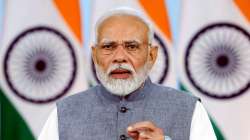Delhi-Meerut RRTS: PM Modi to inaugurate 17 km stretch of rapid rail on October 20 | Details
The first phase, the rapid rail service is going to start from Sahibabad to Duhai which is about 17 kilometres long. During this period, this train will stop at 5 stations which are Sahibabad, Ghaziabad, Guldhar, Duhai, and Duhai terminals.

Prime Minister Narendra Modi will inaugurate India's first Regional Rapid Transit System (RRTS) on October 20. PM Modi will inaugurate the 17 Km priority section on the Delhi-Ghaziabad-Meerut RRTS in Ghaziabad. The NCRTC had earlier said that the entire 82.15 km Delhi-Ghaziabad-Meerut RRTS is targeted to be operational by June 2025.
The RRTS is being developed by the National Capital Region Transport Corporation (NCRTC), a joint venture involving the Government of India and the state governments of Delhi, Haryana, Rajasthan, and Uttar Pradesh.
Here are the details of the Delhi-Meerut RRTS
- The construction of the Delhi-Ghaziabad-Meerut RRTS corridor was started in 2019. The first look of the RRTS train was unveiled a year later.
- These trains share a resemblance with metro trains in terms of their appearance, but they come equipped with distinctive features, including luggage carriers and mini-screens within the coaches.
- This 82km stretch from Delhi to Meerut will be covered in less than 60 minutes by highspeed, high-frequency, safe, reliable, comfortable and green public transit.
- Metro services with 12 stations on 18 kms. stretch between Modipuram and Meerut South stations on RRTS infrastructure will meet the local mobility needs of citizens of Meerut besides providing efficient regional connectivity.
- The RRTS trains feature several commuter-centric facilities such as overhead luggage racks, Wi-Fi, and mobile and laptop charging facilities at every seat.
- All stations and trains will have universal accessibility for the specially-abled. Each train will have a business class with wider seats, more legroom, and coat hangers and a ladies coach. The trains will also come equipped with a vending machine facility.
- RRTS stations will be seamlessly integrated with other transport modes like airport, railway, metro, ISBTs etc. and will be inter-operable ensuring that change of train is not required for moving from one RRTS corridor to another.
- Delhi-Ghaziabad-Meerut RRTS corridor is the first of the three prioritized corridors planned for implementation in Phase-1. The other two are Delhi-Gurugram-Alwar and Delhi-Panipat Corridors.
- The project has been constructed at a cost of Rs 30,274 crore.
- RRTS trains will reduce pollution and road congestion taking more than one lakh private vehicles off-road.
- High-speed mobility will also drive balanced socio-economic growth with increased economic activities and will improve the quality of life of citizens.
Also Read: Delhi-Meerut RRTS Corridor: Route, stations, expected dates, and more